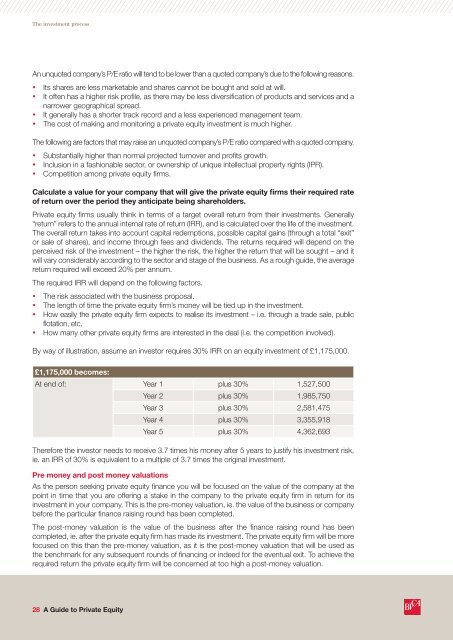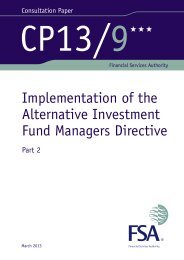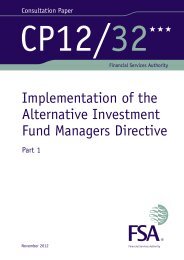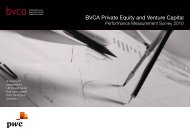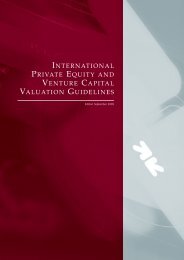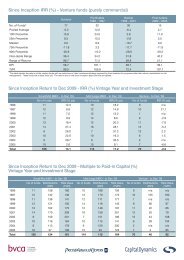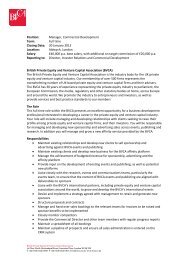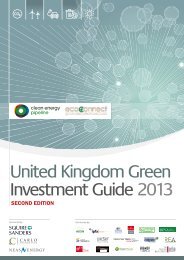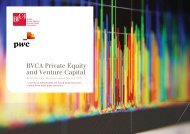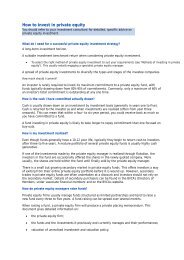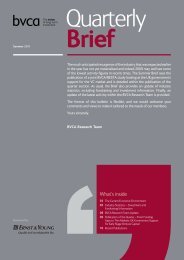A Guide to Private Equity - BVCA admin
A Guide to Private Equity - BVCA admin
A Guide to Private Equity - BVCA admin
You also want an ePaper? Increase the reach of your titles
YUMPU automatically turns print PDFs into web optimized ePapers that Google loves.
The investment process<br />
An unquoted company’s P/E ratio will tend <strong>to</strong> be lower than a quoted company’s due <strong>to</strong> the following reasons.<br />
• Its shares are less marketable and shares cannot be bought and sold at will.<br />
• It often has a higher risk profile, as there may be less diversification of products and services and a<br />
narrower geographical spread.<br />
• It generally has a shorter track record and a less experienced management team.<br />
• The cost of making and moni<strong>to</strong>ring a private equity investment is much higher.<br />
The following are fac<strong>to</strong>rs that may raise an unquoted company’s P/E ratio compared with a quoted company.<br />
• Substantially higher than normal projected turnover and profits growth.<br />
• Inclusion in a fashionable sec<strong>to</strong>r, or ownership of unique intellectual property rights (IPR).<br />
• Competition among private equity firms.<br />
Calculate a value for your company that will give the private equity firms their required rate<br />
of return over the period they anticipate being shareholders.<br />
<strong>Private</strong> equity firms usually think in terms of a target overall return from their investments. Generally<br />
“return” refers <strong>to</strong> the annual internal rate of return (IRR), and is calculated over the life of the investment.<br />
The overall return takes in<strong>to</strong> account capital redemptions, possible capital gains (through a <strong>to</strong>tal “exit”<br />
or sale of shares), and income through fees and dividends. The returns required will depend on the<br />
perceived risk of the investment – the higher the risk, the higher the return that will be sought – and it<br />
will vary considerably according <strong>to</strong> the sec<strong>to</strong>r and stage of the business. As a rough guide, the average<br />
return required will exceed 20% per annum.<br />
The required IRR will depend on the following fac<strong>to</strong>rs.<br />
• The risk associated with the business proposal.<br />
• The length of time the private equity firm’s money will be tied up in the investment.<br />
• How easily the private equity firm expects <strong>to</strong> realise its investment – i.e. through a trade sale, public<br />
flotation, etc.<br />
• How many other private equity firms are interested in the deal (i.e. the competition involved).<br />
By way of illustration, assume an inves<strong>to</strong>r requires 30% IRR on an equity investment of £1,175,000.<br />
£1,175,000 becomes:<br />
At end of: Year 1 plus 30% 1,527,500<br />
Year 2 plus 30% 1,985,750<br />
Year 3 plus 30% 2,581,475<br />
Year 4 plus 30% 3,355,918<br />
Year 5 plus 30% 4,362,693<br />
Therefore the inves<strong>to</strong>r needs <strong>to</strong> receive 3.7 times his money after 5 years <strong>to</strong> justify his investment risk,<br />
ie. an IRR of 30% is equivalent <strong>to</strong> a multiple of 3.7 times the original investment.<br />
Pre money and post money valuations<br />
As the person seeking private equity finance you will be focused on the value of the company at the<br />
point in time that you are offering a stake in the company <strong>to</strong> the private equity firm in return for its<br />
investment in your company. This is the pre-money valuation, ie. the value of the business or company<br />
before the particular finance raising round has been completed.<br />
The post-money valuation is the value of the business after the finance raising round has been<br />
completed, ie. after the private equity firm has made its investment. The private equity firm will be more<br />
focused on this than the pre-money valuation, as it is the post-money valuation that will be used as<br />
the benchmark for any subsequent rounds of financing or indeed for the eventual exit. To achieve the<br />
required return the private equity firm will be concerned at <strong>to</strong>o high a post-money valuation.<br />
28 A <strong>Guide</strong> <strong>to</strong> <strong>Private</strong> <strong>Equity</strong>


